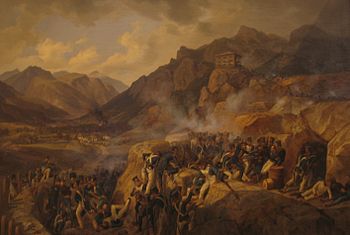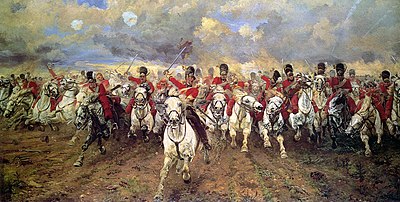Pierre François Joseph Durutte
Pierre François Joseph Durutte | |
|---|---|
Légion d'Honneur Order of Saint Louis |
Pierre François Joseph Durutte (13 July 1767 – 18 April 1827) joined the French army at the beginning of the
After several years of garrison duty, Durutte was sent to a combat command in Italy in 1809. During the
Revolution
Born into a well-to-do merchant family on 13 July 1767 in
In 1795 he became chief of staff to
Early Empire
On 27 August 1803, Durutte received promotion to
His fortunes improved in 1809 when he was given command of a combat division in Italy under Eugène de Beauharnais. His troops included the 3rd and 4th Battalions of the 22nd Light Infantry Regiment, four battalions each of the 23rd and 62nd Line Infantry Regiments, and a foot artillery company consisting of four 6-pound cannons and two 6-inch howitzers.[7] He missed the Battle of Sacile in mid-April.[8] After the Battle of Caldiero at the end of April, Eugène launched a pursuit of Archduke John's retreating army. While the rest of his troops chased John, Eugène directed Durutte on a southerly route to first relieve the siege of Venice and then to rejoin the main army on the Piave River.[9]

On 8 May 1809, Durutte's division was present at the
Durutte fought in the

On 14 June 1809, Durutte led his division in the
On the first day of the
Later Empire

After serving a few months as military governor of

Still in Reynier's VII Corps, Durutte led the 32nd Division at the
During the retreat to France, Durutte led his troops in a clash at

During the Hundred Days Durutte rallied to Napoleon. He was assigned to command the 4th Division of Jean-Baptiste Drouet, Comte d'Erlon's I Corps. Under his command were eight battalions of the 8th, 29th, 85th, and 95th Line Infantry Regiments.[30] The 8th and 29th were commanded by Jean-Gaudens-Claude Pégot, while the 85th and 95th were led by Jean-Louis Brue.[31] On 16 June 1815, his corps commander d'Erlon received conflicting orders from his wing commander Marshal Michel Ney and one of Napoleon's aides, Charles de la Bédoyère. After following de la Bédoyère's order to march to Ligny, he then received Ney's order of recall. Having arrived near the field where the Battle of Ligny was raging, d'Erlon decided to detach Durutte's division and Charles Claude Jacquinot's cavalry. As d'Erlon returned to Ney's wing with his other three infantry divisions, his only instruction to Durutte was to "be prudent". Jacquinot cleared the road of Prussian cavalry, but Durutte stopped at the village of Wagnelée, even as it became clear that the Prussians were retreating. Brigadier Brue, frustrated by his superior's inaction, insubordinately demanded that the division advance. But Durutte, overwhelmed by his responsibility, refused to budge and a great opportunity passed, one of several mischances for the French that day. As it happened, d'Erlon arrived too late to assist Ney in the Battle of Quatre Bras.[32]
At the

As Marcognet's division crested the ridge, the 2nd
Meanwhile, Durutte supervised the attack of his 1,700-man 2nd Brigade on the extreme right. About 1:30 PM, he sent his troops into the little valley in front of Papelotte and La Haye, covered by 18 horse artillery pieces and Jacquinot's cavalry. The original skirmish line recoiled before enemy fire and Durutte quickly reinforced it with battalions in open order. He also sent a horse battery to take Smohain under point-blank fire. Two battalions soon overran Papelotte and victory seemed to be at hand. At this moment, Durutte rode back to the ridge and found to his dismay that the 1st Brigade was crushed and the ground to his left covered with rampaging British cavalry. With the Dutch-Belgian cavalry brigade of Charles Étienne de Ghigny advancing downhill toward them, he had the men of the 2nd Brigade execute a hasty retreat covered by one of Jacquinot's regiments. The brigade was able to withdraw behind a battalion square from the VI Corps. These troops drove off Ghigny's light horsemen with the help of a nearby artillery battery.[37]
As the Prussian attack against the VI Corps gained momentum,
Notes
- ^ a b c d e f g h i j k l Mullié, Durutte
- ^ Smith, 43
- ^ a b Chandler Dictionary, 134
- ^ a b Broughton, Durutte
- ^ Arnold Marengo, 275
- ^ Arnold Marengo, 245-256
- ^ Bowden & Tarbox, 103
- ^ Schneid, 181-182
- ^ Schneid, 79
- ^ Bowden & Tarbox, 111
- ^ Schneid, 81
- ^ Epstein, 123
- ^ Schneid, 86-87
- ^ Bowden & Tarbox, 118
- ^ Arnold Napoleon, 110-111
- ^ Bowden & Tarbox, 128
- ^ Arnold Napoleon, 155-156
- ^ Arnold Napoleon, 163
- ^ "Nieuw Nederlandsch biografisch woordenboek. Deel 8 · DBNL".
- ^ Het Franse Nederland: de inlijving 1810-1813: De juridische en bestuurlijke ... geredigeerd door A.M.J.A. Berkvens, J. Hallebeek, A.J.B. Sirks, p. 99 [1]
- ^ Chandler Campaigns, 1113
- ^ Smith, 402-403
- ^ Smith, 420
- ^ Smith, 440
- ^ Smith, 450
- ^ Smith, 462
- ^ Smith, 471
- ^ Smith, 474
- ^ Chandler Campaigns, 1004
- ^ Smith, 539
- ^ Haythornthwaite, 179
- ^ Hamilton-Williams, 228-229
- ^ a b Hamilton-Williams, 306-307
- ^ Hamilton-Williams, 288
- ^ Hamilton-Williams, 301
- ^ Hamilton-Williams, 302
- ^ Hamilton-Williams, 308
- ^ Hamilton-Williams, 328
- ^ Hamilton-Williams, 344
- ^ Hamilton-Williams, 346
References
- Arnold, James R. Marengo & Hohenlinden. Barnsley, South Yorkshire, UK: Pen & Sword, 2005. ISBN 1-84415-279-0
- Arnold, James R. Napoleon Conquers Austria. Westport, Conn.: Praeger Publishers, 1995. ISBN 0-275-94694-0
- Broughton, Tony. napoleon-series.org Generals Who Served in the French Army during the Period 1789-1815
- ISBN 0-02-523670-9
- Chandler, David G. The Campaigns of Napoleon. New York: Macmillan, 1966
- Epstein, Robert M. Napoleon's Last Victory and the Emergence of Modern War. Lawrence, Kansas: University Press of Kansas, 1994.
- Hamilton-Williams, David. Waterloo - New Perspectives: The Great Battle Reappraised. NY: John Wiley & Sons, 1994. ISBN 0-471-05225-6
- Haythornthwaite, Philip J. Uniforms of Waterloo. NY: Hippocrene Books, 1974. ISBN 0-88254-283-4
- (in French) Mullié, Charles. Biographie des célébrités militaires des armées de terre et de mer de 1789 a 1850. 1852.
- Schneid, Frederick C. Napoleon's Italian Campaigns: 1805-1815. Westport, Conn.: Praeger Publishers, 2002. ISBN 0-275-96875-8
- ISBN 1-85367-276-9
